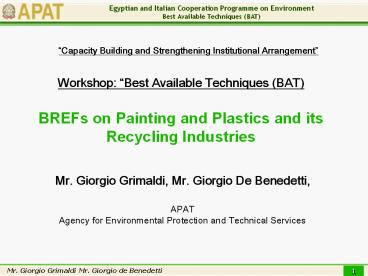Diapositiva 1 - PowerPoint PPT Presentation
Title:
Diapositiva 1
Description:
Capacity Building and Strengthening Institutional Arrangement Workshop: Best Available Techniques (BAT) BREFs on Painting and Plastics and its Recycling ... – PowerPoint PPT presentation
Number of Views:49
Avg rating:3.0/5.0
Title: Diapositiva 1
1
Capacity Building and Strengthening
Institutional Arrangement
Workshop Best Available Techniques (BAT)
BREFs on Painting and Plastics and its
Recycling Industries
Mr. Giorgio Grimaldi, Mr. Giorgio De Benedetti,
APAT Agency for Environmental Protection and
Technical Services
2
Index
- Introduction
- Methodology of analysis of a production cycle
- Final Remarks
- Reference documents
3
1. Introduction
Painting
- Finishing is a process affecting both aesthetic
and mechanical aspects of a product. A quality
product not only looks good but has a protective
and durable surface coating as well. - Painting production is a chemical process
involving a lot of natural and artificial
substances, often with a significant potential
risk for health and safety and for the
environment. - Potential dangerous effluents emission in the
various enviromental matrices, significant water
and energy consumption, bad and dangerous smell
emissions are the most relevant environmental
issues of the production cycle. - Painting products are used in many civil and
industrial applications, widely spreaded, thus
resulting in a lot of diffuse sources of
emissions, not easily to be monitored and
controlled.
4
1. Introduction
Plastics
- Production of plastics is a complex process,
mainly of chemical nature, involving a lot of
materials with a significant potential risk for
health and safety and for the environment. - Potential dangerous effluents emission and
significant energy consumption in the production
cycle (blend preparation and moulding) are to be
attentively faced. - Tipical products spam from raw plastic (polymers)
for further working to a large variety of
objects, widely present in every part of our
daily life. - The life cycle of plastic objects is of a
relatively short duration, thus requiring short
term replacement. - The large amount of plastic objects put in the
environment calls for a great attention to the
heritage that could be leaved to the future
generations. Then recycling and reuse have to be
strongly encouraged.
5
Analysis of a production cycle
2. Methodology of analysis of a production cycle
the specific segment of an economic or industrial
activity with an homogeneous production
the analysis of every phase of the working process
Environmental analysis of a production cycle
AIMED TO EVALUATE
production cycle
1. materials energy comsumption 2. primary
resources consumption 3. dangerous effluents
emission 4. impact and risk factors 5. applied
techniques in the process 6. best available
techniques
- Optimize the use of resources in the process
- Compare the environmental performance of the
installation versus the pertinent industry
IN ORDER TO
6
Splitting up into phases the process cycle
2. Methodology of analysis of a production cycle
- phase analysis
INPUT Recycling
7
Methodology of analysis
2. Methodology of analysis of a production cycle
- Input incoming materials, natural resources,
energy
- Output final product, waste, dangerous effluents
and effects in the different environmental
matrices
- Reuse of materials inside the production process
- Balance of materials, energy and water
- Indirect environmental effects
- Integrated approach IPPC, BAT, BREF
8
3. Final remarks
Painting industry
- A specific BREF on the painting industry has not
yet been implemented at EU level. - Existing BREFs on chemical industry can give some
general indication on valid measures that can be
implemented, mainly on filtration systems and on
water and energy saving techniques. - Also in absence of a comparative analysis of the
adopted techniques aimed to identify and to
propose formal BATs, the primary and secondary
prevention analyses, are a good starting point to
improve an effective environmental safeguard
program. - Uncontrolled dispersion of working residuals in
the vast variety of civil and industrial
applications of painting products remains one
the most critical problems to be faced.
9
3. Final remarks
Plastic and its recycling industry
- Plastic production can have a considerable impact
on the environment, due to the intrinsic nature
of the involved substances and processes,
resulting in both air and water pollution, but
mainly in large non biodegradable wastes. - Implementation of (candidate) BATs in every
production phase (from the raw material selection
to the final handworks production) can
significantly reduce emission of dangerous
pollutants in every environmental matrix. - Attentive water and energy balances in the
affected production phases can result in both
primary resources saving and significant economic
advantages. - Priority should be given to the recovery of
plastic material at the end of life of products,
in order both to reduce the amount of dangerous
material left in the environment and to save
resources, i.e. through production of energy.
10
4. Reference documents
Painting industry
- Some indication of possible BAT could be found on
pigments production, which are only one of the
raw material used as input in the painting
industry - Speciality Inorganic Chemicals
http//eippcb.jrc.es/pages/Fmembers.htm - Methodology for environmental analysis of
production cycles APAT 36/2006 (Italian
language) - http//www.apat.gov.it/Media/cicli_produttivi/Avvi
o.htm - Analysis of dangerous materials (Cap. 3
Painting, Cap. 5 Plastics) - ARPA Emilia Romagna,
2005 (Italian language) - Athmospheric pollution reduction from industrial
activities - Lombardia Region Official Bullettin,
2003 (Italian language)
11
4. Reference documents
Plastics and its recycling industry
- A specific BREF has not still been prepared.
Some indications could be found only for polymers
production, thus covering only the preparation of
the raw materials used in the plastic industry.
http//eippcb.jrc.es/pages/Fmembers.htm - Methodology for environmental analysis of
production cycles APAT 36/2006 (Italian
language) - http//www.apat.gov.it/Media/cicli_produttivi/Avvi
o.htm - Analysis of dangerous materials (Cap. 3
Painting, Cap. 5 Plastics) - ARPA Emilia Romagna,
2005 (Italian language) - Athmospheric pollution reduction from industrial
activities - Lombardia Region Official Bullettin,
2003 (Italian language)































